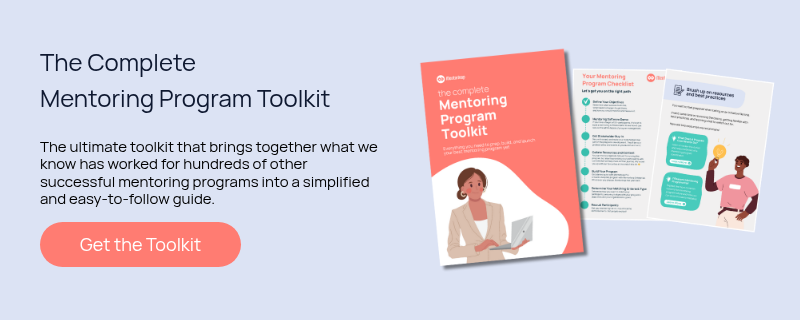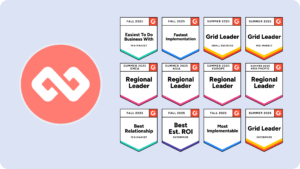Companies the world over are constantly seeking innovative ways to stay ahead of the competition. One area that is often overlooked, yet holds immense potential, is knowledge transfer and sharing within organizations. Despite its importance, many companies are missing the boat when it comes to effectively harnessing the power of knowledge transfer.
So what can you put in place now to ensure this doesn’t happen to you?
In this article, we will explore why companies are missing out and delve into how mentoring can be a powerful tool for knowledge transfer and sharing.
Companies Are Missing the Boat on Knowledge Transfer & Sharing
Knowledge sharing is vital to any organization. It enables employees to perform their tasks more efficiently, make better decisions, and drive innovation. However, despite its significance, many organizations do not have a formal knowledge transfer or sharing strategy in place.
The Misconception About Knowledge Sharing
One of the primary reasons for this oversight is the notion that knowledge transfer just occurs naturally through daily interactions among employees. While informal knowledge sharing is undoubtedly beneficial, it often fails to capture and distribute tacit knowledge – the valuable insights and expertise that are not explicitly documented.
Team members may also not feel they’re enough of an expert to formally “teach” others. But if companies create a culture in which informally teaching and sharing knowledge with others is valued and expected, then knowledge transfer can become more of a normal, daily practice.
With these misconceptions prevalent in organizations, critical knowledge can easily be lost when employees leave or move to different roles. Which brings us to…
Knowledge Erosion
Companies experience knowledge erosion when senior team members retire and take their skills and knowledge with them. Without a formal knowledge transfer and sharing strategy, all the valuable insights and expertise accumulated over the years could vanish into thin air. This loss not only affects the organization’s ability to make informed decisions but also hinders the growth and development of other employees.
Tools and Systems
A big reason that companies are missing the boat on knowledge transfer and sharing is that oftentimes, the tools and systems for managing knowledge transfer and sharing are simply not in place. Or—maybe they are—but team members aren’t comfortable using them.
Additionally, many organisations see the cost of acquiring the tools and systems necessary to create effective programs as a hindrance. But preserving knowledge doesn’t have to be expensive. Case in point: a mentoring program can be up to 680 times cheaper than executive coaching and 373 times cheaper than in-person training sessions.
The Benefits of Having A Knowledge Sharing Strategy
Nowadays, employees frequently change roles or move to different organizations. So it follows that the need for effective knowledge transfer has become even more critical. Without a structured approach to capturing and sharing knowledge, organizations risk losing their competitive edge and struggling to adapt to new challenges.
Implementing a formal knowledge sharing strategy can have numerous benefits for organizations. Firstly, it ensures that critical knowledge is preserved and passed on to future generations of employees. By documenting tacit knowledge and making it accessible to others, organizations can create a repository of expertise that can be tapped into whenever needed.
Moreover, a well-designed knowledge transfer strategy promotes collaboration and fosters a culture of continuous learning within the organization. When employees know that their knowledge and insights are valued and actively sought after, they are more likely to engage in knowledge sharing activities. This, in turn, leads to increased innovation, improved problem-solving capabilities, and enhanced overall performance.
Another advantage of having a formal knowledge transfer strategy is the ability to identify knowledge gaps and address them proactively. By understanding the areas where knowledge is lacking or outdated, organizations can provide targeted training and development opportunities to fill those gaps. This ensures that employees have the necessary skills and knowledge to excel in their roles and contribute to the organization’s success.
In conclusion, the importance of knowledge transfer and sharing cannot be overstated. Organizations that neglect to implement a formal strategy risk losing valuable insights, hindering growth, and struggling to adapt to changing circumstances. By recognizing the significance of tacit knowledge and investing in effective knowledge transfer methods, organizations can unlock their full potential and stay ahead of the competition.
Planning Your Knowledge Sharing Strategy
When it comes to planning your knowledge transfer strategy, there are several important steps to take.
- Identify knowledge gaps within your organization. This can be done through a thorough assessment that examines critical knowledge areas that need to be transferred. By identifying these gaps, you can better understand where the focus of your knowledge sharing efforts should be.
- Once you have identified the knowledge gaps, the next step is to design programs, such as mentoring programs, that align with these areas. Mentoring is not only great for increasing engagement, minimizing turnover, and making younger workers feel nurtured and valued, it’s also a powerful knowledge transfer tool.
- Establishing clear objectives for your programs is another crucial step in the planning process. Clearly defining the objectives, whether it is succession planning, onboarding, or skills development, will help guide the overall implementation and evaluation process. This clarity will ensure that everyone involved understands the purpose and goals of the mentoring programs.
- Measuring and evaluating the effectiveness of your programs is essential for continuous improvement. By establishing metrics to measure the impact of the programs, you can gather valuable data that will help you make necessary adjustments. Regular evaluation will allow you to identify any areas that need improvement and make changes accordingly.
Considering starting a mentoring program? Check out our guide to getting started or download our ultimate mentoring program toolkit!
Why Mentoring? Understanding the Benefits of Mentoring for Knowledge Transfer and Sharing
In a recent study, the American Productivity & Quality Center (APQC) found that more than half of featured organisations reported using mentoring as a way to transfer discipline- or job-specific expertise from one employee to another.
Not only can mentoring be used to share industry-specific and tacit knowledge, it can also be used to:
- Teach hard and soft skills among team members
- Help with organisational succession planning, onboarding, and training
Let’s take a closer look at the latter three.
Succession Planning
As experienced employees approach retirement, mentoring programs allow them to pass on their knowledge and expertise to the next generation of leaders. This ensures a smooth transition of critical knowledge and minimizes the impact of talent gaps within the organization.
Succession planning is not just about finding replacements for key positions; it is about developing a pipeline of capable individuals who can step into leadership roles with confidence. Mentoring plays a crucial role in this process by providing a platform for experienced employees to share their wisdom, insights, and lessons learned over the years. Through one-on-one interactions and guidance, mentors can help mentees develop the necessary skills, knowledge, and mindset to excel in their future roles.
Mentoring, as we mentioned previously, also fosters a culture of continuous learning and growth within the organization. By encouraging knowledge transfer through mentoring relationships, organizations can ensure that valuable expertise is not lost when employees retire or move on to other opportunities. This proactive approach to succession planning helps maintain stability and continuity, even in times of significant organizational change.
With an effective mentoring program, junior employees will feel and be more prepared to assume more advanced responsibilities. This is because more advanced skills and expertise sharing can be prioritized in pairs for mentees to build subject matter expertise in preparation for leadership positions.
Onboarding
New employees often face a steep learning curve when joining an organization. Mentoring programs can help alleviate this challenge by pairing them with experienced mentors who can guide and support them through the onboarding process. This accelerates the integration of new employees, enabling them to contribute to the organization’s success more quickly.
During the onboarding phase, mentors can provide valuable insights into the organization’s culture, values, and unwritten rules. They can help new employees navigate the complexities of their roles, understand the expectations, and establish relationships with key stakeholders. Mentoring also provides a safe space for new employees to ask questions, seek advice, and receive constructive feedback, which can boost their confidence and engagement.
Moreover, mentoring goes beyond just practical guidance. It can also help new employees develop a sense of belonging and connection within the organization. By having a mentor who genuinely cares about their growth and success, new employees are more likely to feel supported, motivated, and empowered to reach their full potential.
While there’s no definitive answer on how long it takes to completely onboard a new employee, it usually takes anywhere from six months to a year for people to feel like they’re adding value.
Mentoring can help get company newbies ready to confidently tackle projects without constant guidance in a shorter span of time.
Training
Mentoring programs can be a powerful complement to traditional training initiatives. While training provides employees with foundational knowledge, mentoring offers real-world application and contextual understanding. By working closely with a mentor, employees can hone their skills, gain practical insights, and bridge the gap between theory and practice.
Training programs often focus on teaching specific technical or functional skills, but mentoring can provide the necessary guidance to apply those skills effectively in a given context. Mentors can share their experiences, share best practices, and provide feedback on the mentees’ performance, allowing them to refine their abilities and grow professionally.
Furthermore, mentoring can help employees develop essential soft skills, such as communication, leadership, and problem-solving. These skills are often difficult to teach in a classroom setting but can be effectively cultivated through ongoing mentorship. By observing and learning from their mentors’ behaviours, mentees can enhance their interpersonal skills and become well-rounded professionals.
“Tell me and I forget, teach me and I may remember, involve me and I learn.”
This famous quote by Benjamin Franklin perfectly captures the essence of mentoring. It emphasizes the importance of active involvement and experiential learning, which mentoring provides in abundance. Through meaningful interactions and hands-on experiences, mentees are actively engaged in their own development, leading to deeper understanding, increased confidence, and accelerated growth.
Top Tip: Using in-house talent via a mentoring program is an effective and lower-cost alternative to more formal ways of training staff, especially for industry or function-specific tacit knowledge. According to Lauren Trees, principal research lead at APQC:
“Tacit knowledge, which resides in an expert’s head and surfaces in response to a situation or action, can be exchanged most effectively through one-on-one interactions between mentors and mentees who work side by side for a period of time.”
Leveraging Technology to Facilitate Knowledge Transfer
In today’s digital age, leveraging technology is vital to facilitate effective knowledge transfer and sharing. The rapid advancements in technology have revolutionized the way organizations operate and communicate. By embracing various technological tools and platforms, companies can enhance their knowledge management processes and promote a culture of continuous learning and growth.
Knowledge Management Systems
An effective way to leverage technology for knowledge transfer is by investing in robust knowledge management systems. These systems are designed to facilitate the organization, storage, and retrieval of learning assets. By capturing and documenting critical knowledge, organizations can ensure that it is easily accessible to employees whenever needed. This allows organizations to be intentional with retaining organizational knowledge and prevent its loss while making learning opportunities readily available to its people.
Collaboration Tools
Collaboration tools encourage cross-functional information sharing, allowing employees to work together seamlessly, regardless of their physical location. Platforms like project management software or internal social networks provide a space for employees to share ideas, collaborate on projects, and learn from each other’s expertise. This fosters a culture of knowledge sharing and collaboration, ultimately leading to improved productivity and innovation within the organization.
Mentoring Software
One of the ways organizations can utilize technology to facilitate knowledge transfer is through using mentoring software to run their mentoring programs. These platforms provide a unique opportunity for mentors and mentees to connect and exchange knowledge, regardless of geographical constraints, as well as receive more continuous guidance through software features.
Mentoring software also benefits the program coordinators who run them. We’ve talked about the value of mentoring programs in facilitating knowledge transfer and sharing. However, running one isn’t always easy, especially for those who haven’t done it before. So if you’re going to run a mentoring program as part of your knowledge sharing initiatives, you might as well do everything you can to do it right. And an easy and cost-effective way of ensuring that is by enlisting the help of mentoring software.
‘Why incur the additional cost?’ you might be asking. Well, for starters, it’s not as expensive as you might think! But also, the benefits of having software far outweigh the initial perceived savings of not having one. Mentoring software allows you to:
- manage your mentors and mentees easily
- conduct equitable, bias-free matching
- provide participants guidance throughout the mentoring journey
- have 100% visibility across your program’s growth and performance
- gather data and feedback as your program runs
- slice and dice your data and create ready-to-share reports
All while saving you tons and tons of time!
Learn more:
The Time to Implement a Mentoring Program is Today
Mentoring isn’t just a perk you can offer to employees for your retention or talent attraction strategy, it can also be used as a tool to increase productivity and keep knowledge within the organisation—meaning important company knowledge stays in your company and helps develop your people.
Keen to know how a Mentorloop-powered mentoring program can help your organization’s knowledge sharing efforts?






